Analysis of Drought Characteristics Projections for the Tibetan Plateau Based on the GFDL-ESM2M Climate Model
Abstract
1. Introduction
2. Materials and Methods
2.1. Study Area
2.2. Data Source and Climate Model
2.3. Methods
2.3.1. Standardized Precipitation-Evapotranspiration Index (SPEI)
2.3.2. Mann–Kendall (M-K) Test
2.3.3. Run Theory
3. Results
3.1. Model Simulation Capability Assessment
3.2. Spatiotemporal Variation of SPEI
3.2.1. Temporal Variation Characteristics of SPEI
3.2.2. Spatial Variation Characteristics of SPEI
3.3. Analysis of Drought Change Characteristics
3.3.1. Variation Characteristics of Drought Frequency in Different Grades
3.3.2. Variation Characteristics of Drought Intensity under Different Climatic Scenarios
3.3.3. Migration Probabilities and Return Periods of Different Drought Durations
4. Discussion
4.1. Adaptability Analysis of SPEI Index
4.2. Difference Analysis of Drought Variation at Different Time Scales
4.3. Analysis of Difference in Spatiotemporal Variation of Drought Characteristics
5. Conclusions
Author Contributions
Funding
Institutional Review Board Statement
Informed Consent Statement
Data Availability Statement
Acknowledgments
Conflicts of Interest
References
- Dai, A. Increasing drought under global warming in observations and models. Nat. Clim. Chang. 2013, 3, 52–58. [Google Scholar] [CrossRef]
- Liu, Z.P.; Wang, Y.Q.; Shao, M.G.; Jia, X.X.; Li, X.L. Spatiotemporal analysis of multiscalar drought characteristics across the Loess Plateau of China. J. Hydrol. 2016, 534, 281–299. [Google Scholar] [CrossRef]
- Duan, W.L.; Zou, S.; Chen, Y.N.; Daniel, N.; Fang, G.H.; Wang, Y. Sustainable water management for cross-border resources: The Balkhash Lake Basin of Central Asia, 1931–2015. J. Clean. Prod. 2020, 263, 121614. [Google Scholar] [CrossRef]
- Lin, Y.; Grimm, N.B. Modelling potential impacts of climate change on water and nitrate export from a mid-sized, semiarid watershed in the US Southwest. Clim. Chang. 2013, 120, 419–431. [Google Scholar]
- Zha, X.B.; Luo, P.P.; Zhu, W.; Wang, S.T.; Lyu, J.Q.; Zhou, M.M.; Huo, A.D.; Wang, Z.H. A bibliometric analysis of the research on Sponge City: Current situation and future development direction. Ecohydrology 2021, 14, e2328. [Google Scholar] [CrossRef]
- Huang, W.J.; Duan, W.L.; Chen, Y.N. Rapidly declining surface and terrestrial water resources in Central Asia driven by socioeconomic and climatic changes. Sci. Total. Environ. 2021, 784, 147193. [Google Scholar] [CrossRef]
- Mu, D.R.; Luo, P.P.; Lyu, J.Q.; Zhou, M.M.; Huo, A.D.; Duan, W.; Nover, D.; He, B.; Zhao, X.L. Impact of temporal rainfall patterns on flash floods in Hue City, Vietnam. J. Flood Risk Manag. 2020, 14, e12668. [Google Scholar] [CrossRef]
- Xie, D.N.; Duan, L.; Si, G.Y.; Liu, W.J.; Zhang, T.; Mulder, J. Long–term 15N balance after single–dose input of 15N–labeled NH4+ and NO3– in a subtropical forest under reducing N deposition. Glob. Biogeochem. Cycles 2021, 35, e2021GB006959. [Google Scholar] [CrossRef]
- Zhang, Y.; Luo, P.P.; Zhao, S.F.; Kang, S.X.; Wang, P.B.; Zhou, M.M.; Lyu, J.Q. Control and remediation methods for eutrophic lakes in the past 30 years. Water Sci. Technol. 2020, 81, 1099–1113. [Google Scholar] [CrossRef]
- Feng, S.; Fu, Q. Expansion of global drylands under a warming climate. Atmos. Chem. Phys. Discuss. 2013, 13, 14637–14665. [Google Scholar] [CrossRef]
- Huang, J.P.; Yu, H.P.; Guan, X.D.; Wang, G.Y.; Guo, R.X. Accelerated dryland expansion under climate change. Nat. Clim. Chang. 2016, 6, 166–171. [Google Scholar] [CrossRef]
- United Nations Convention to Combat Desertification. The Global Land Outlook, 1st ed.; UNCCD: Bonn, Germany, 2017. [Google Scholar]
- Liu, Y.W.; Liu, Y.B.; Wang, W. Inter-comparison of satellite-retrieved and Global Land Data Assimilation System-simulated soil moisture datasets for global drought analysis. Remote Sens. Environ. 2019, 220, 1–18. [Google Scholar] [CrossRef]
- Akhtar-Schuster, M.; Stringer, L.C.; Metternicht, G.; Barger, N.N.; Chotte, J.-L.; Kust, G. Assessing the impact of science in the implementation of the United Nations Convention to Combat Desertification. Land 2022, 11, 568. [Google Scholar] [CrossRef]
- Lkhagvadorj, N.; Zhang, J.H.; Battsetseg, T.; Yang, S.S.; Sonam, R.; Ahmed, P.F.; Pangali, S.T.P. Assessment of drought impact on net primary productivity in the terrestrial ecosystems of Mongolia from 2003 to 2018. Remote Sens. 2021, 13, 2522. [Google Scholar]
- Huang, J.L.; Zhai, J.Q.; Jiang, T.; Wang, Y.J.; Li, X.C.; Wang, R.; Xiong, M.; Su, B.D.; Fischer, T. Analysis of future drought characteristics in China using the regional climate model CCLM. Clim. Dyn. 2018, 50, 507–525. [Google Scholar] [CrossRef]
- Wang, Y.X.; Lv, J.; Jamie, H.; Wang, Y.C.; Sun, H.Q.; Lucy, J.B.; Ma, M.M.; Su, Z.C.; Michael, E. Linking drought indices to impacts to support drought risk assessment in Liaoning province, China. Nat. Hazards Earth Syst. Sci. 2020, 20, 889–906. [Google Scholar] [CrossRef]
- Zhu, Y.N.; Lei, L.; Zhao, Y.; Liang, Z.M.; Li, H.H.; Wang, L.Z.; Wang, Q.M. Regional comprehensive drought disaster risk dynamic evaluation based on projection pursuit clusterin. Water Policy 2018, 20, 410–428. [Google Scholar] [CrossRef]
- Hu, Z.; Wu, Z.; Islam, A.R.M.T.; You, X.Y.; Liu, C.; Li, Q.; Zhang, X.S. Spatiotemporal characteristics and risk assessment of agricultural drought disasters during the winter wheat-growing season on the Huang-Huai-Hai Plain, China. Theor. Appl Climatol. 2021, 143, 1393–1407. [Google Scholar] [CrossRef]
- Orimoloye, I.R.; Ololade, O.O.; Belle, J.A. Satellite-based application in drought disaster assessment using terra MOD13Q1 data across free state province, South Africa. J. Environ. Manag. 2021, 285, 112112. [Google Scholar] [CrossRef]
- Li, L.; Zhang, R. Effect of upper-level air temperature changes over the Tibetan Plateau on the genesis frequency of Tibetan Plateau vortices at interannual timescales. Clim. Dyn. 2021, 57, 341–352. [Google Scholar] [CrossRef]
- Abraham, J.G.; Danielle, C.V.K.; Greg, R.H.; Garry, W. Catchment-scale drought: Capturing the whole drought cycle using multiple indicators. Hydrol. Earth Syst. Sci. 2020, 24, 1985–2002. [Google Scholar]
- Annette, H.; Laura, C.; Reed, M. Evaluating the relative importance of precipitation, temperature and land-cover change in the hydrologic response to extreme meteorological drought conditions over the North American High Plains. Hydrol. Earth Syst. Sci. 2019, 23, 1931–1950. [Google Scholar]
- Wang, F.; Yang, H.B.; Wang, Z.M.; Zhang, Z.Z.; Li, Z.H. Drought evaluation with CMORPH satellite precipitation data in the Yellow River Basin by using gridded standardized precipitation evapotranspiration index. Remote Sens. 2019, 11, 485. [Google Scholar] [CrossRef]
- Yang, J.; Chang, J.X.; Wang, Y.M.; Li, Y.Y.; Hu, H.; Chen, Y.T.; Huang, Q.; Yao, J. Comprehensive drought characteristics analysis based on a nonlinear multivariate drought index. J. Hydrol. 2018, 557, 651–667. [Google Scholar] [CrossRef]
- Immerzeel, W.W.; Beek, L.P.H.v.; Bierkens, M.F.P. Climate change will affect the Asian water towers. Science 2010, 328, 1382–1385. [Google Scholar] [CrossRef] [PubMed]
- Pritchard, H.D. Retraction: Asia′s glaciers are a regionally important buffer against drought. Nature 2018, 555, 274. [Google Scholar] [CrossRef]
- Wu, G.X.; Liu, Y.M.; He, B.; Bao, Q.; Duan, A.M.; Jin, F.F. Thermal controls on the Asian summer monsoon. Sci. Rep. 2012, 2, 404. [Google Scholar] [CrossRef]
- Wang, M.R.; Wang, J.; Duan, A.M.; Liu, Y.M.; Zhou, S.W. Coupling of the quasi-biweekly oscillation of the Tibetan Plateau summer monsoon with the arctic oscillation. Geophys. Res. Lett. 2018, 45, 7756–7764. [Google Scholar] [CrossRef]
- Duan, A.M.; Xiao, Z.X. Does the climate warming hiatus exist over the Tibetan Plateau? Sci. Rep. 2015, 5, 13711. [Google Scholar] [CrossRef]
- An, S.; Chen, X.Q.; Zhang, X.Y.; Lang, W.G.; Ren, S.L.; Xu, L. Precipitation and minimum temperature are primary climatic controls of alpine grassland autumn phenology on the Qinghai-Tibet Plateau. Remote Sens. 2020, 12, 431. [Google Scholar] [CrossRef]
- Resources and Environment Data Cloud Platform of the Chinese Academy of Sciences. Available online: http://www.resdc.cn/ (accessed on 11 November 2021).
- Dunne, J.P.; John, J.G.; Adcroft, A.J.; Griffies, S.M.; Hallberg, R.W.; Shevliakova, E.; Stouffer, R.J.; Cooke, W.; Dunne, K.A.; Harrison, M.J.; et al. GFDL’s ESM2 Global coupled climate–carbon Earth system models. Part I. J. Clim. 2012, 25, 6646–6665. [Google Scholar] [CrossRef]
- Ng, B.; Cai, W.J.; Walsh, K. Nonlinear feedbacks associated with the Indian Ocean Dipole and their response to Global warming in the GFDL-ESM2M coupled climate model. J. Clim. 2014, 27, 3904–3919. [Google Scholar] [CrossRef]
- Dunne, J.P.; John, J.G.; Shevliakova, E.; Stouffer, R.J.; Krasting, J.P.; Malyshev, S.L.; Milly, P.C.D.; Sentman, L.T.; Adcroft, A.J.; Cooke, W.; et al. GFDL’s ESM2 Global coupled climate–carbon Earth system models. Part II. J. Clim. 2013, 26, 2247–2267. [Google Scholar] [CrossRef]
- Jia, K.; Ruan, Y.F.; Yang, Y.Z.; You, Z. Assessment of CMIP5 GCM simulation performance for temperature projection in the Tibetan Plateau. Earth Space Sci. 2019, 6, 2362–2378. [Google Scholar] [CrossRef]
- Bi, Y.J.; Zhao, J.; Wu, D.; Zhao, Y. Spatiotemporal variations of future potential evapotranspiration in the Beijing-Tianjin-Hebei region under GFDL-ESM2M climate model. Trans. Chin. Soc. Agric. Eng. 2020, 36, 140–149. [Google Scholar]
- Ma, D.Y.; Deng, H.Y.; Yin, Y.H.; Wu, S.H.; Zhang, D. Sensitivity of arid/humid patterns in China to future climate change under a high-emissions scenario. J. Geogr. Sci. 2019, 29, 29–48. [Google Scholar] [CrossRef]
- Pan, X.D.; Zhang, L.; Huang, C.L. Future climate projection in Northwest China with RegCM4.6. Earth Space Sci. 2020, 7, e2019EA000819. [Google Scholar] [CrossRef]
- National Tibetan Plateau Data Center. Future Climate Projection of China Based on Regcm4.6 (2007–2099). Available online: http://data.tpdc.ac.cn (accessed on 16 November 2021).
- Yao, N.; Li, L.C.; Feng, P.Y.; Feng, H.; Liu, D.L.; Liu, Y.; Jiang, K.T.; Hu, X.T.; Li, Y. Projections of drought characteristics in China based on a standardized precipitation and evapotranspiration index and multiple GCMs. Sci. Total Environ. 2020, 704, 135245. [Google Scholar] [CrossRef] [PubMed]
- Liu, Y.; Tian, J.Y.; Liu, R.H.; Ding, L.Q. Influences of climate change and ruman activities on NDVI changes in China. Remote Sens. 2021, 13, 4326. [Google Scholar] [CrossRef]
- Vicente-Serrano, S.M.; Beguerà a, S.; López-Moreno, J.I. A Multiscalar drought index sensitive to Global warming: The standardized precipitation evapotranspiration index. J. Clim. 2010, 23, 1696–1718. [Google Scholar] [CrossRef]
- Ndehedehe, C.E.; Agutu, N.O.; Ferreira, V.G.; Getirana, A. Evolutionary drought patterns over the Sahel and their teleconnections with low frequency climate oscillations. Atmosp. Res. 2020, 233, 104700. [Google Scholar] [CrossRef]
- Zhang, B.Q.; Long, B.; Wu, Z.Y.; Wang, Z.K. An evaluation of the performance and the contribution of different modified water demand estimates in drought modeling over water-stressed regions. Land Degrad. Develop. 2017, 28, 1134–1151. [Google Scholar] [CrossRef]
- Zhang, R.W.; Zhao, C.Y.; Ma, X.F.; Brindha, K.; Han, Q.F.; Li, C.F.; Zhao, X.N. Projected spatiotemporal dynamics of drought under Global warming in Central Asia. Sustainability 2019, 11, 4421. [Google Scholar] [CrossRef]
- Zhang, Y.Z.; Huang, C.C.; Tan, Z.H.; Chen, Y.L.; Qiu, H.J.; Huang, C.; Li, Y.Q.; Zhang, Y.X.; Li, X.G.; Shulmeister, J.; et al. Prehistoric and historic overbank floods in the Luoyang Basin along the Luohe River, middle Yellow River basin, China. Quat. Int. 2019, 521, 118–128. [Google Scholar] [CrossRef]
- Jung, I.W.; Chang, H. Climate change impacts on spatial patterns in drought risk in the Willamette River Basin, Oregon, USA. Theor. Appl. Climatol. 2012, 108, 355–371. [Google Scholar] [CrossRef]
- Chen, S.D.; Zhang, L.P.; Liu, X.; Guo, M.Y.; She, D.X.; Qian, B.D. The use of SPEI and TVDI to assess temporal-spatial variations in drought conditions in the Middle and Lower Reaches of the Yangtze River Basin, China. Adv. Meteorol. 2018, 2018, 1–11. [Google Scholar] [CrossRef]
- Li, X.Z.; Huang, W.R. How long should the pre-existing climatic water balance be considered when capturing short-term wetness and dryness over China by using SPEI? Sci. Total Environ. 2021, 786, 147575. [Google Scholar] [CrossRef]
- Thornthwaite, C.W. An approach toward a rational classification of climate. Soil Sci. 1948, 66, 77. [Google Scholar] [CrossRef]
- Willmott, C.J.; Rowe, C.M.; Mintz, Y. Climatology of the terrestrial seasonal water cycle. J. Climatol. 1985, 5, 589–606. [Google Scholar] [CrossRef]
- Wei, X.D.; Wang, N.; Luo, P.P.; Yang, J.; Zhang, J.; Lin, K.L. Spatiotemporal assessment of land marketization and its driving forces for sustainable urban–rural development in Shaanxi Province in China. Sustainability 2021, 13, 7755. [Google Scholar] [CrossRef]
- Güçlü, Y.S. Improved visualization for trend analysis by comparing with classical Mann-Kendall test and ITA. J. Hydrol. 2020, 584, 124674. [Google Scholar] [CrossRef]
- Hamed, K.H. Exact distribution of the Mann–Kendall trend test statistic for persistent data. J. Hydrol. 2008, 365, 86–94. [Google Scholar] [CrossRef]
- Meng, X.Y.; Gao, X.; Li, S.Y.; Lei, J.Q. Spatial and temporal characteristics of vegetation NDVI changes and the driving forces in Mongolia during 1982–2015. Remote Sens. 2020, 12, 603. [Google Scholar] [CrossRef]
- Han, R.C.; Li, Z.L.; Li, Z.J.; Han, Y.Y. Spatial–temporal assessment of historical and future meteorological droughts in China. Atmosphere 2021, 12, 787. [Google Scholar] [CrossRef]
- Wu, R.N.; Zhang, J.q.; Bao, Y.H.; Guo, E.L. Run theory and copula-based drought risk analysis for songnen grassland in Northeastern China. Sustainability 2019, 11, 6032. [Google Scholar] [CrossRef]
- Moyé, L.A.; Kapadia, A.S. Predictions of drought length extreme order statistics using run theory. J. Hydrol. 1995, 169, 95–110. [Google Scholar] [CrossRef]
- Guo, H.; Bao, A.M.; Liu, T.; Guli·, J.; Felix, N.; Jiang, L.L.; Alishir, K.; Philippe, D.M. Spatial and temporal characteristics of droughts in Central Asia during 1966–2015. Sci. Total Environ. 2017, 624, 1523–1538. [Google Scholar] [CrossRef]
- Gallegati, M. Multiscale evaluation of CMIP5 models using wavelet-based descriptive and diagnostic techniques. Clim. Chang. 2022, 170, 41. [Google Scholar] [CrossRef]
- Giuseppe, M.; Alfonso, S. Evaluation of parametric and statistical approaches for the regionalization of flow duration curves in intermittent regimes. J. Hydrol. 2013, 480, 19–32. [Google Scholar]
- Wang, C.P.; Huang, M.T.; Zhai, P.M. Change in drought conditions and its impacts on vegetation growth over the Tibetan Plateau. Adv. Clim. Chang. Res. 2021, 12, 333–341. [Google Scholar] [CrossRef]
- Li, L.; Zhang, R.H.; Wen, M.; Lv, J.M. Regionally different precipitation trends over the Tibetan Plateau in the warming context: A perspective of the Tibetan Plateau vortices. Geophys. Res. Lett. 2021, 48, e2020GL091680. [Google Scholar] [CrossRef]
- Gao, Y.H.; Li, X.; Leung, L.R.; Chen, D.L.; Xu, J.W. Aridity changes in the Tibetan Plateau in a warming climate. Environ. Res. Lett. 2015, 10, 034013. [Google Scholar] [CrossRef]
- Liu, J.; Zhang, T.J.; Wu, Q.B.; Jiang, G.L. Recent climate changes in the Northwestern Qaidam Basin inferred from geothermal gradients. Earth Sci. Inform. 2020, 13, 261–270. [Google Scholar] [CrossRef]
- Jia, Y.X.; Wu, H.B.; Zhang, W.C.; Li, Q.; Yu, Y.Y.; Zhang, C.X.; Sun, A.Z. Quantitative cenozoic climatic reconstruction and its implications for aridification of the Northeastern Tibetan Plateau. Palaeogeogr. Palaeoclimatol. Palaeoecol. 2021, 567, 110244. [Google Scholar] [CrossRef]
- Zarei, A.R.; Shabani, A.; Moghimi, M.M. Accuracy Assessment of the SPEI, RDI and SPI drought indices in regions of Iran with different climate conditions. Pure Appl. Geophys. 2021, 178, 1387–1403. [Google Scholar] [CrossRef]
- Xu, K.; Wu, C.H.; Zhang, C.; Hu, B.X. Uncertainty assessment of drought characteristics projections in humid subtropical basins in China based on multiple CMIP5 models and different index definitions. J. Hydrol. 2021, 600, 126502. [Google Scholar] [CrossRef]
- Xu, K.; Yang, D.W.; Yang, H.B.; Li, Z.; Qin, Y.; Shen, Y. Spatio-temporal variation of drought in China during 1961–2012: A climatic perspective. J. Hydrol. 2015, 526, 253–264. [Google Scholar] [CrossRef]
- Wang, L.; Chen, W.; Zhou, W. Assessment of future drought in Southwest China based on CMIP5 multimodel projections. Adv. Atmosp. Sci. 2014, 31, 1035–1050. [Google Scholar] [CrossRef]
- Easterling, D.R.; Kunkel, K.E.; Wehner, M.F.; Sun, L. Detection and attribution of climate extremes in the observed record. Weather. Clim. Extrem. 2016, 11, 17–27. [Google Scholar] [CrossRef]
- Donat, M.G.; Lowry, A.L.; Alexander, L.V.; O’Gorman, P.A.; Maher, N. More extreme precipitation in the world′s dry and wet regions. Nat. Clim. Chang. 2016, 6, 508–513. [Google Scholar] [CrossRef]
- Allan, R.P.; Soden, B.J. Atmospheric warming and the amplification of precipitation extremes. Science 2008, 321, 1481–1484. [Google Scholar] [CrossRef] [PubMed]
- Wang, C.H.; Wang, Z.L.; Kong, Y.; Zhang, F.M.; Yang, K.; Zhang, T.J. Most of the Northern Hemisphere permafrost remains under climate change. Sci. Rep. 2019, 9, 3295. [Google Scholar] [CrossRef]
- Yang, K.; Wu, H.; Qin, J.; Lin, C.G.; Tang, W.J.; Chen, Y.Y. Recent climate changes over the Tibetan Plateau and their impacts on energy and water cycle: A review. Global. Planet. Chang. 2014, 112, 79–91. [Google Scholar] [CrossRef]
- Kang, S.C.; Xu, Y.W.; You, Q.L.; Flügel, W.A.; Pepin, N.; Yao, T.D. Review of climate and cryospheric change in the Tibetan Plateau. Environ. Res. Lett. 2010, 5, 015101. [Google Scholar] [CrossRef]
- Eyring, V.; Cox, P.M.; Flato, G.M.; Gleckler, P.J.; Abramowitz, G.; Caldwell, P.; Collins, W.D.; Gier, B.K.; Hall, A.D.; Hoffman, F.M.; et al. Taking climate model evaluation to the next level. Nat. Clim. Chang. 2019, 9, 102–110. [Google Scholar] [CrossRef]
- Xu, Y.; Xu, C.H. Preliminary Assessment of simulations of climate changes over China by CMIP5 multi-models. Atmosp. Ocean. Sci. Lett. 2012, 5, 489–494. [Google Scholar]
- Su, F.G.; Duan, X.L.; Chen, D.L.; Hao, Z.C.; Cuo, L. Evaluation of the Global climate models in the CMIP5 over the Tibetan Plateau. J. Clim. 2013, 26, 3187–3208. [Google Scholar] [CrossRef]
- Keyantash, J.; Dracup, J.A. The quantification of drought: An evaluation of drought indices. Bull. Am. Meteorol. Soc. 2002, 83, 1167–1180. [Google Scholar] [CrossRef]
- Cook, B.I.; Mankin, J.S.; Marvel, K.; Williams, A.P.; Smerdon, J.E.; Anchukaitis, K.J. Twenty-first century drought projections in the CMIP6 forcing scenarios. Earth′s Future 2020, 8, e2019EF001461. [Google Scholar] [CrossRef]
- Yadu, P.; Farshid, F.; Yusuke, S.; Julien, B.; Peter, B.; Anne, G.; Dieter, G.; Gosling, S.N.; Manolis, G.; Lukas, G.; et al. Global terrestrial water storage and drought severity under climate change. Nat. Clim. Chang. 2021, 11, 226–233. [Google Scholar]
- Miguel, B.; Manuel, D.; Santiago, S.; Rocío, H.; Zhao, Y.C.; Gaitán, J.J.; Nicolas, G.; Hugo, S.; Vincent, M.; Anika, L.; et al. Global ecosystem thresholds driven by aridity. Science 2020, 367, 787–790. [Google Scholar]
- Saleska, S.R.; Wu, J.; Kaiyu, G.; Araujo, A.C.; Huete, A.; Nobre, A.D.; Restrepo-Coupe, N. Dry-season greening of Amazon forests. Nature 2016, 531, E4–E5. [Google Scholar] [CrossRef] [PubMed]
- RonnieJ, A.C.; María, B.; Jerónimo, P. Benchmarking of drought and climate indices for agricultural drought monitoring in Argentina. Sci. Total Environ. 2021, 790, 148090. [Google Scholar]
- Sutanto, S.J.; Lanen, H.A.J.V.; Wetterhall, F.; Llort, X. Potential of Pan-European seasonal hydrometeorological drought forecasts obtained from a multihazard early warning system. Bull. Am. Meteorol. Soc. 2020, 101, E368–E393. [Google Scholar] [CrossRef]
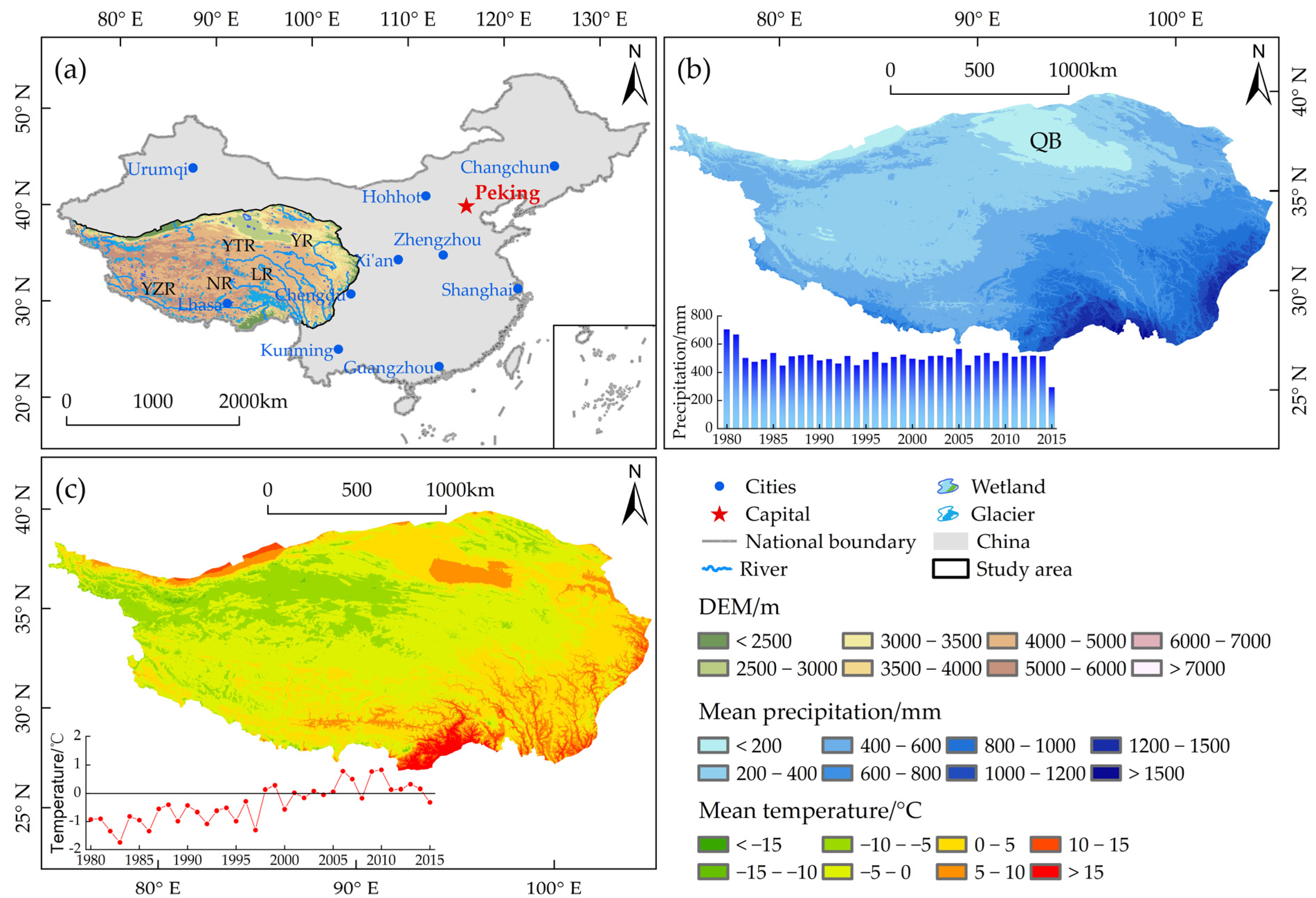
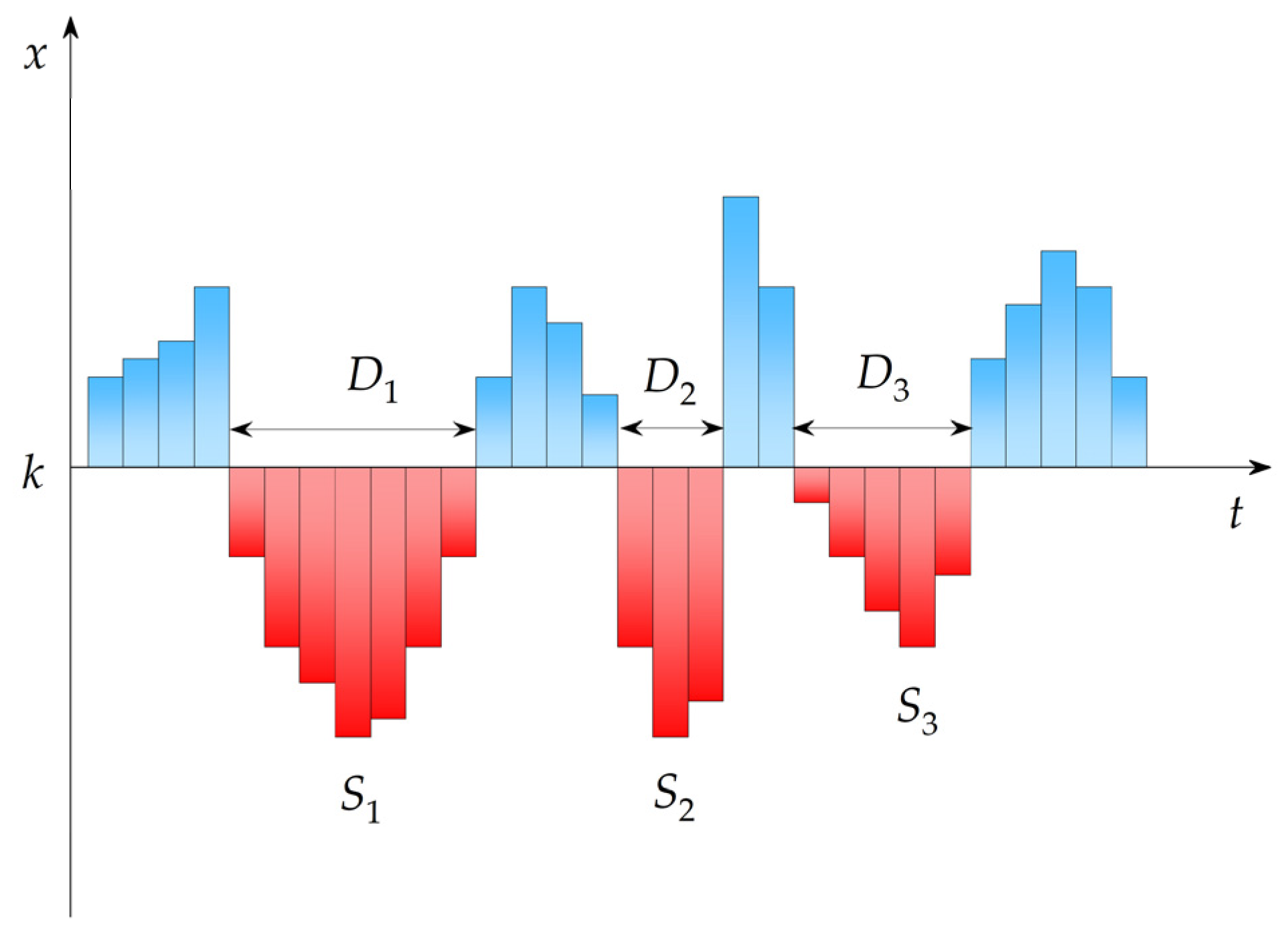
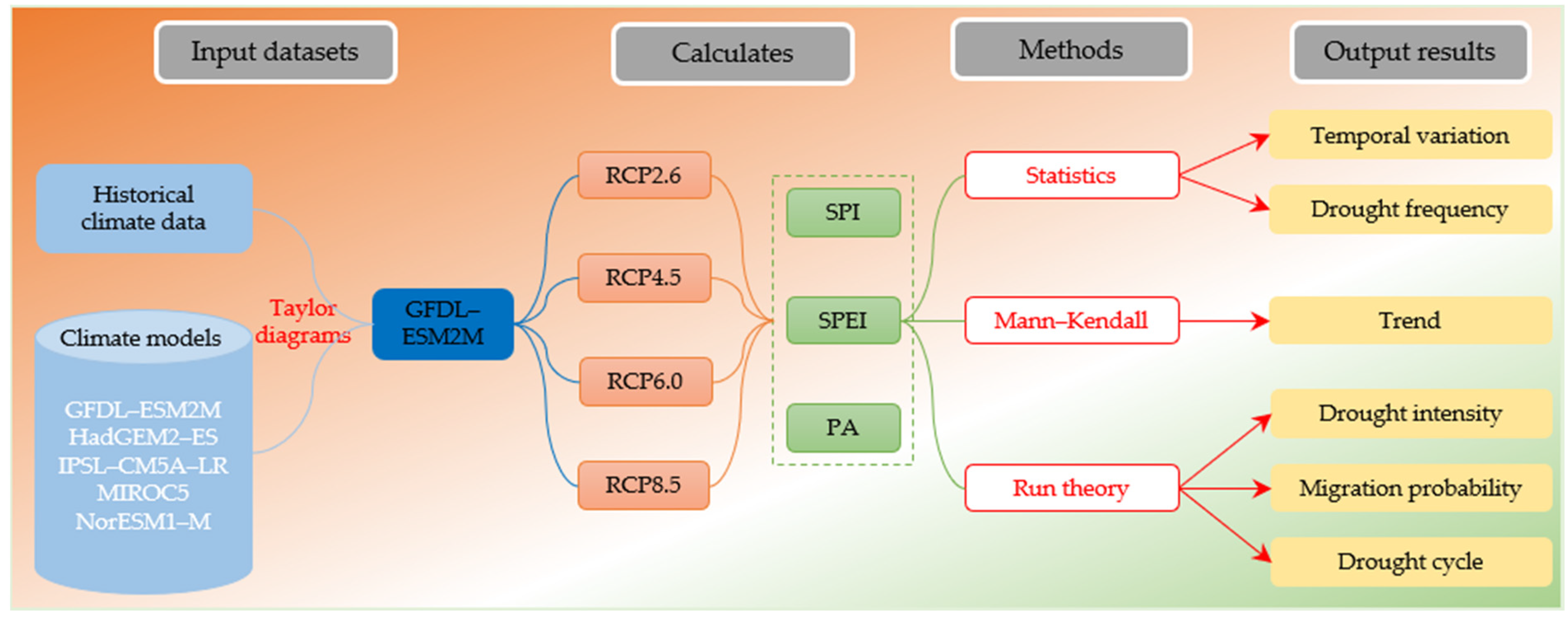
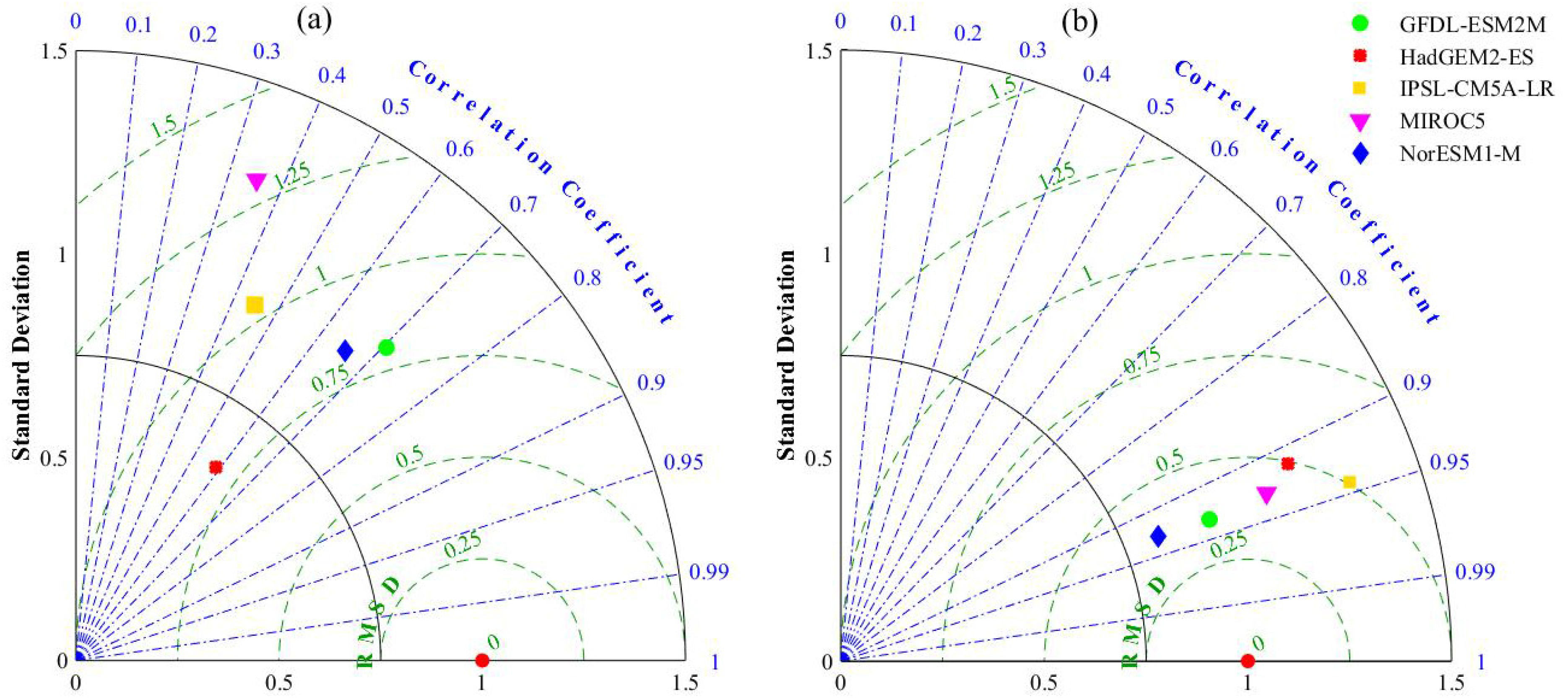
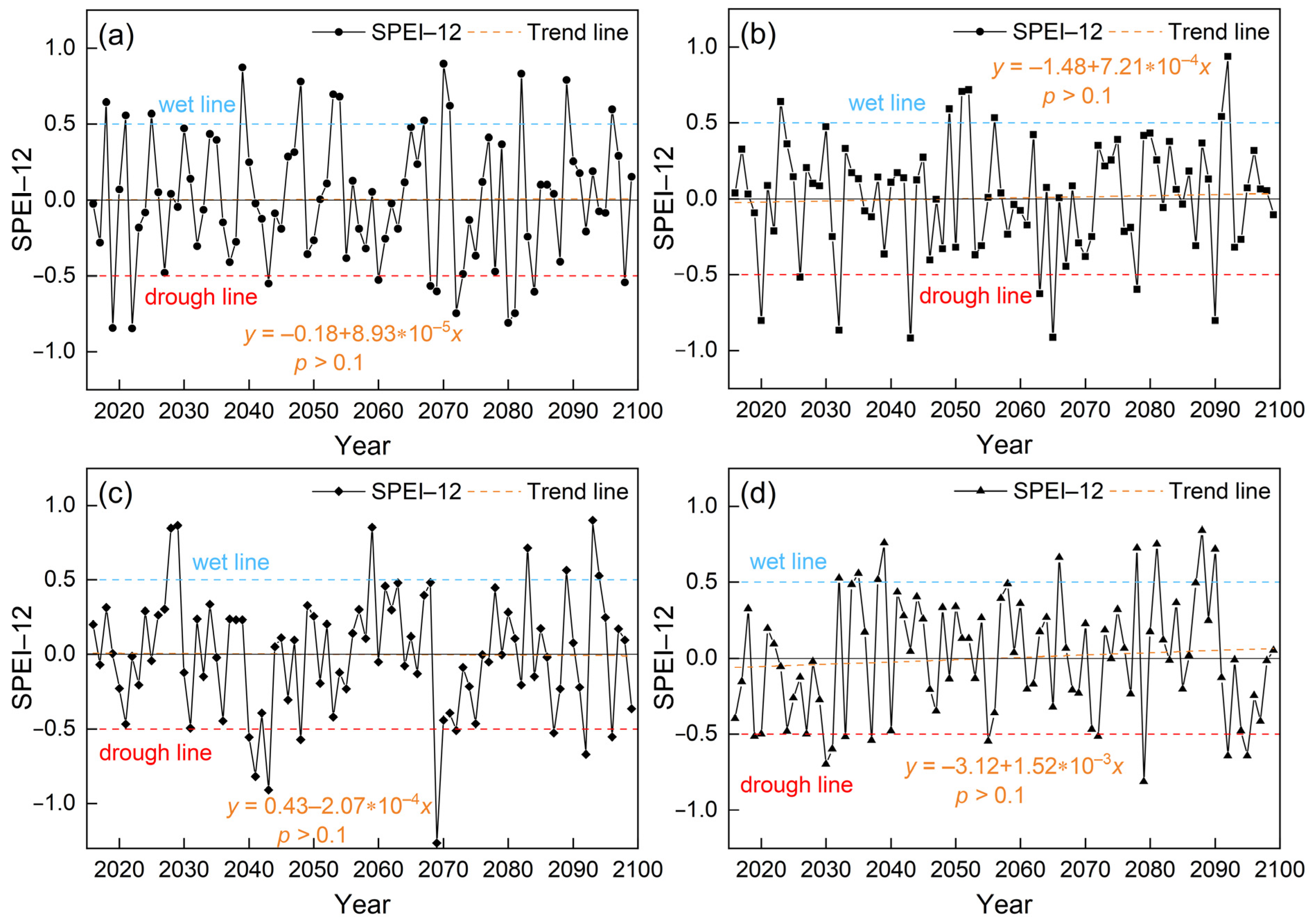
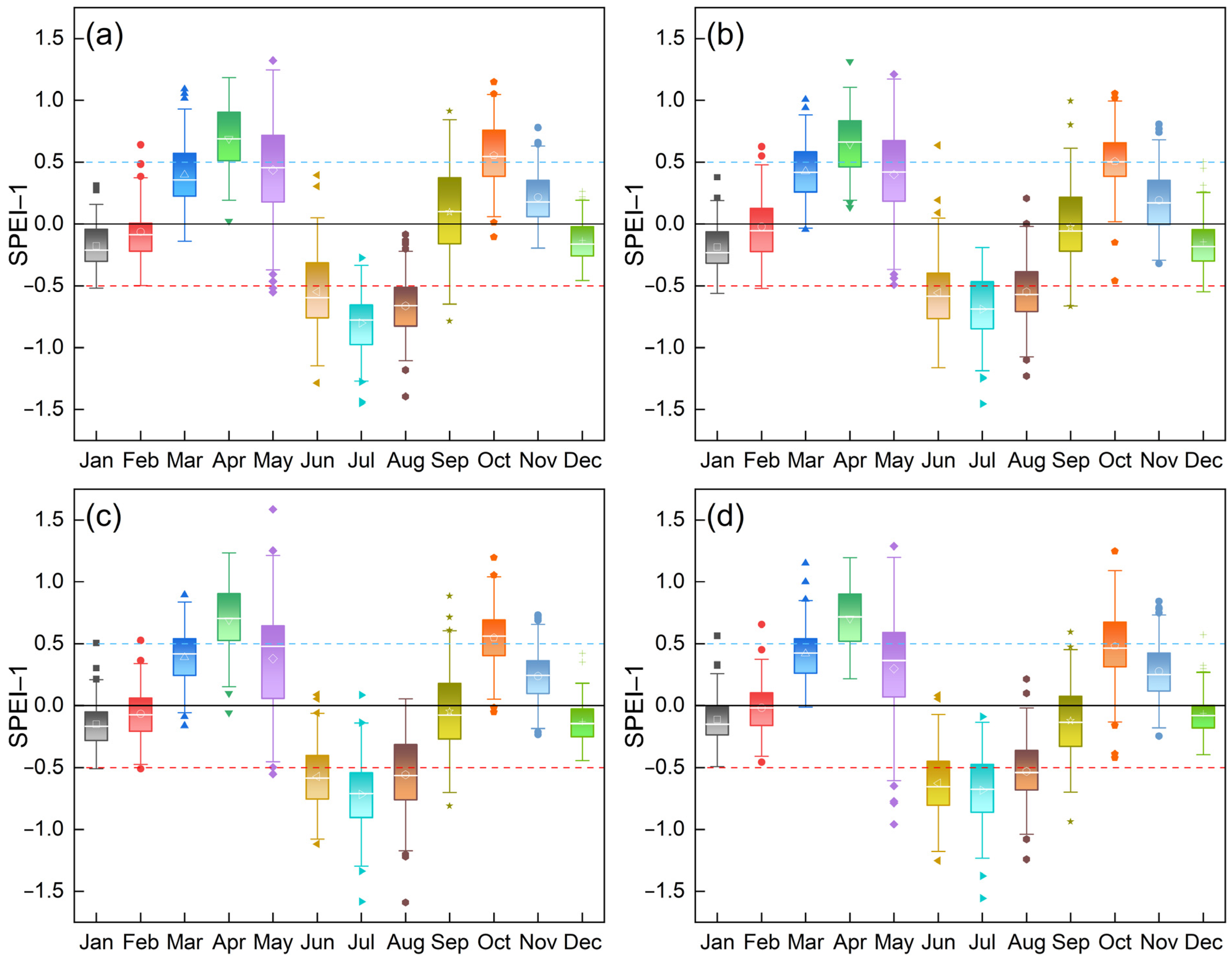


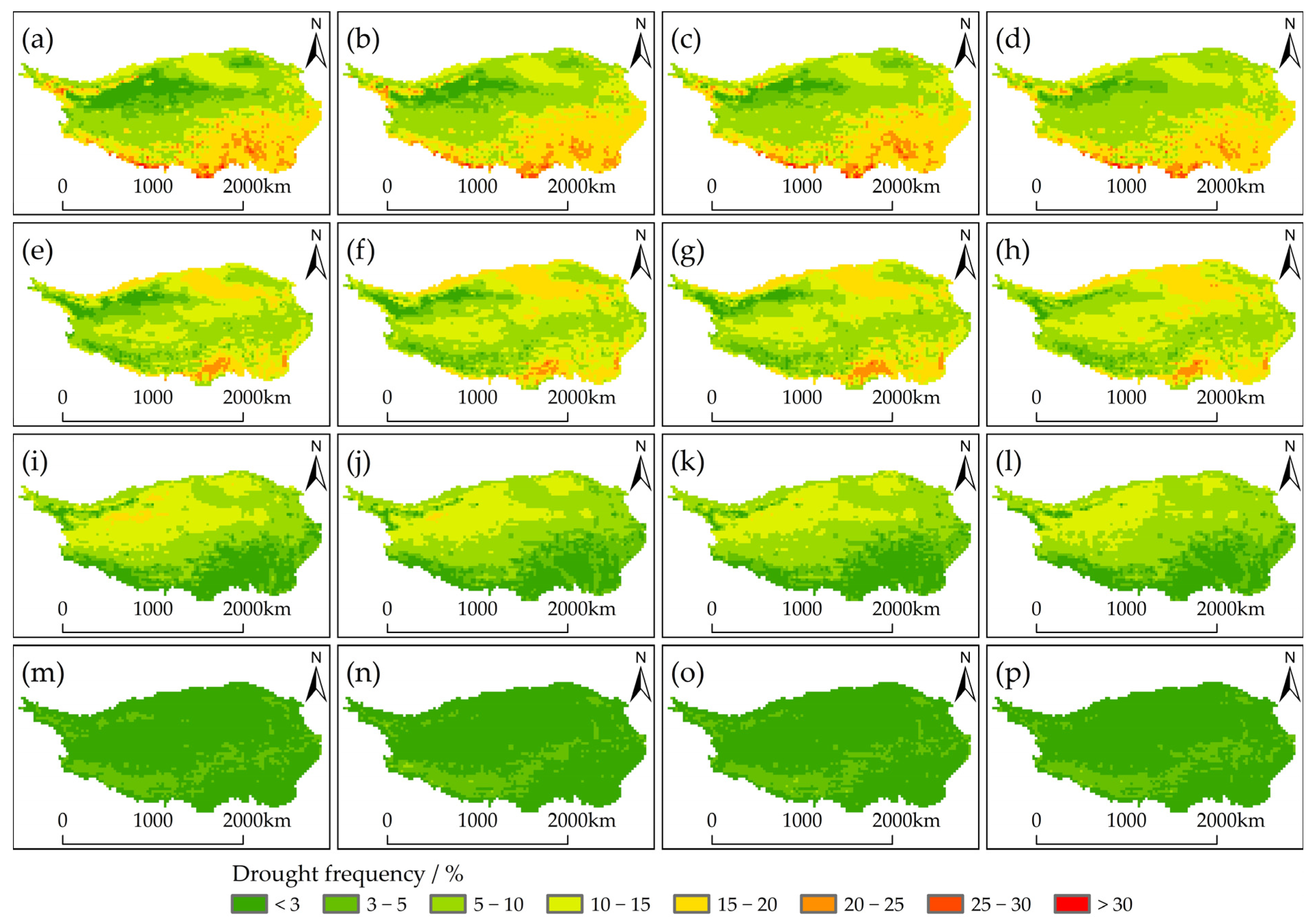
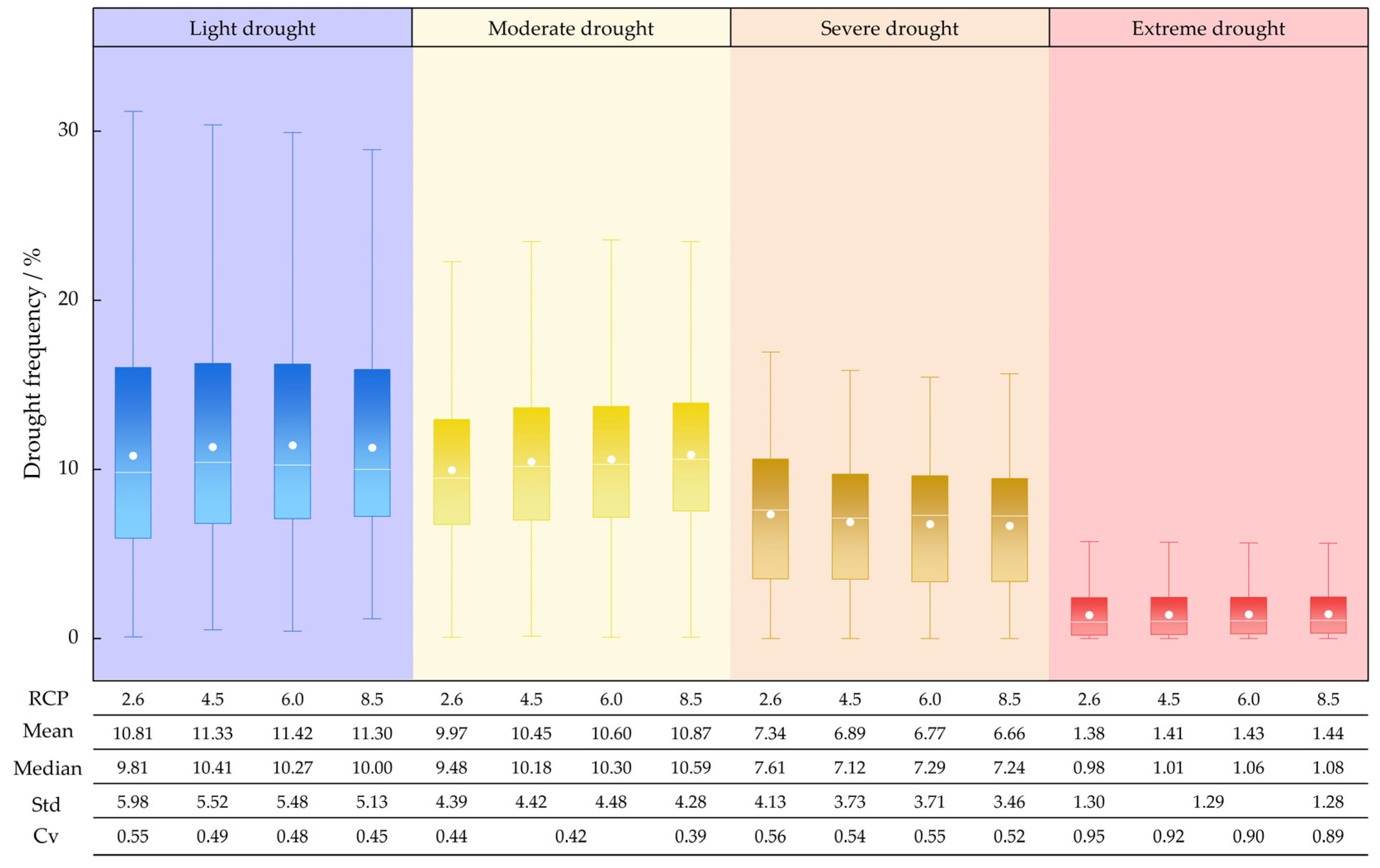

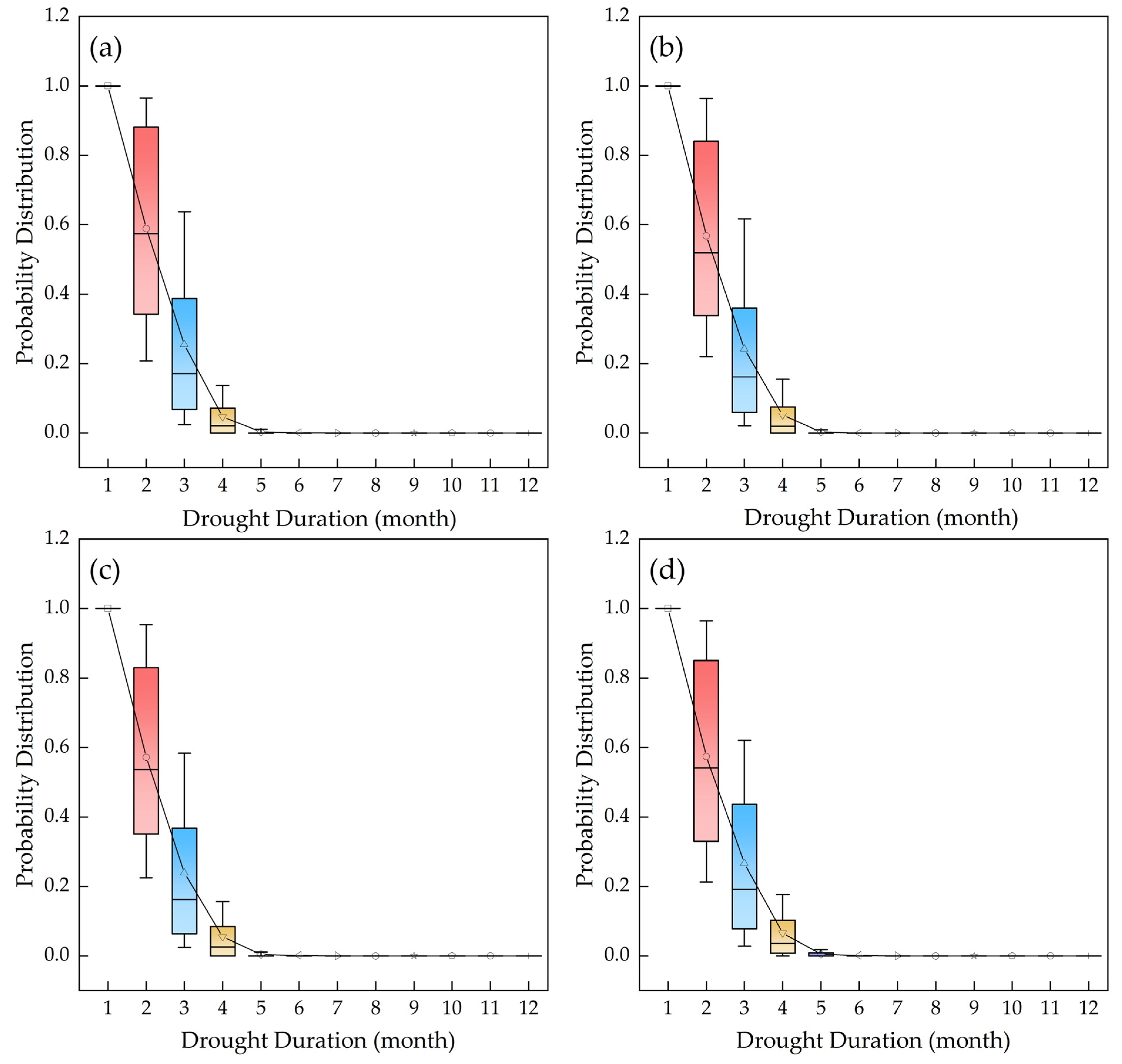
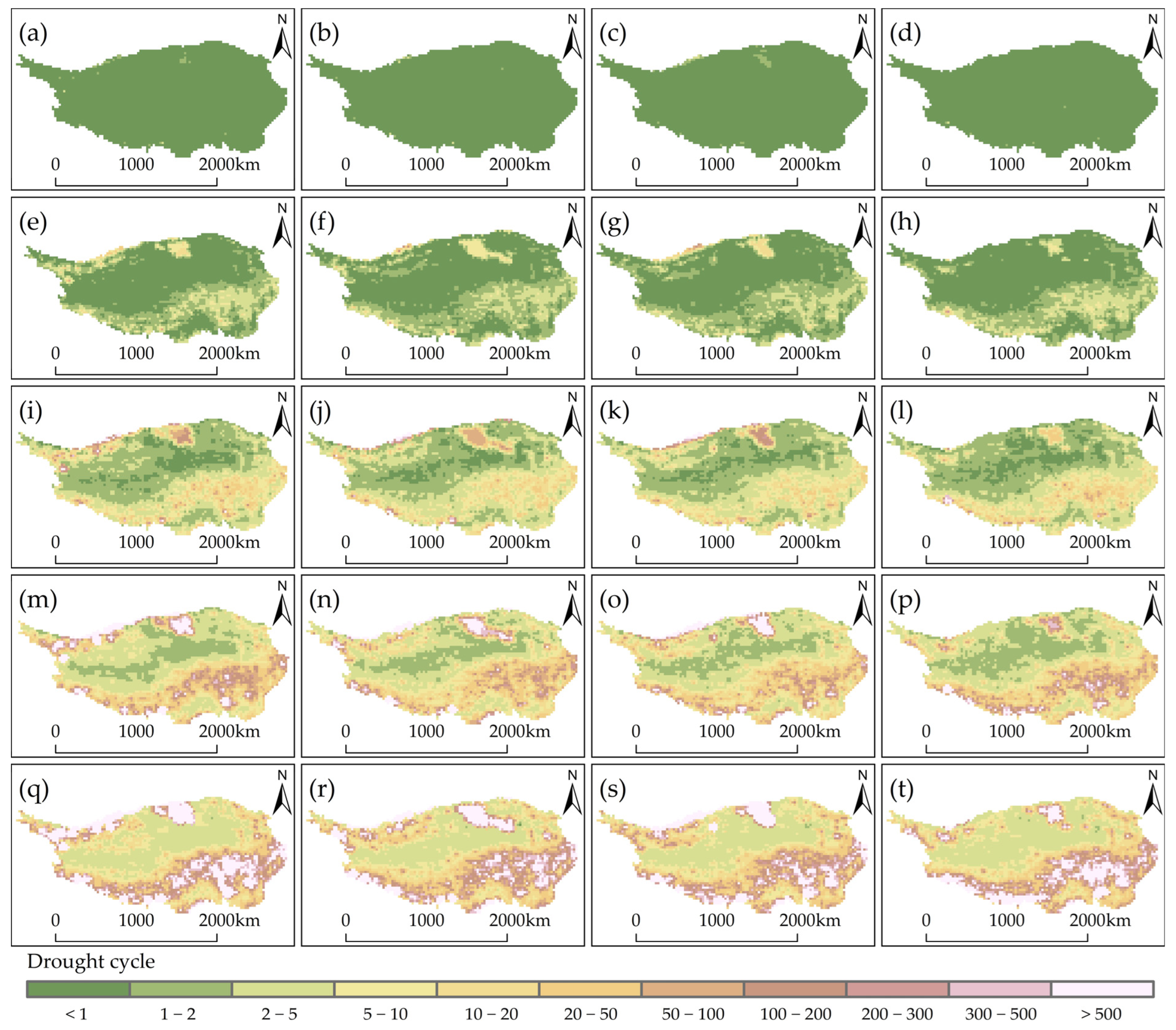
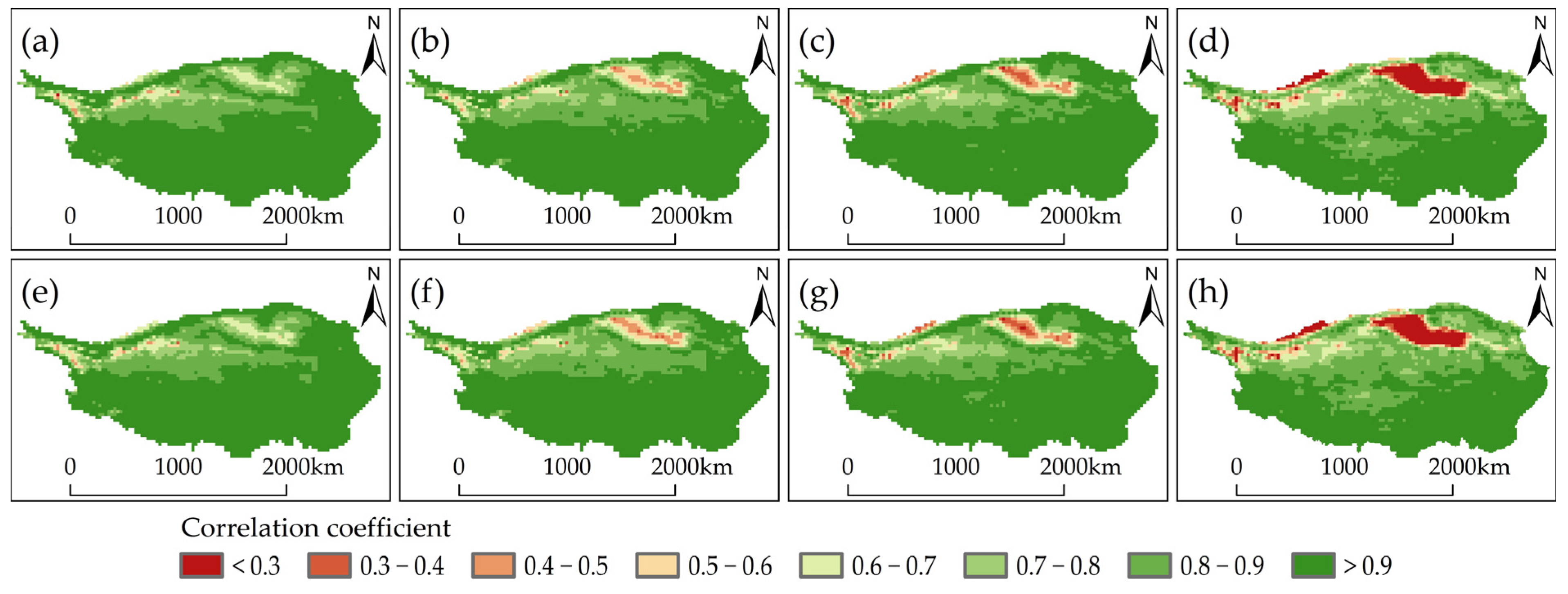
| SPEI Value | Category | SPEI Value | Category | SPEI Value | Category |
|---|---|---|---|---|---|
| <−2 | Extreme drought | −1 to −0.5 | Light drought | 1 to 1.5 | Moderately wet |
| −2 to −1.5 | Severe drought | −0.5 to 0.5 | Normal | 1.5 to 2 | Severely wet |
| −1.5 to −1 | Moderate drought | 0.5 to 1 | Lightly wet | >2 | Extremely wet |
| Data Type | Slope | |Z| | Description | Class | Slope | |Z| | Description | Class |
|---|---|---|---|---|---|---|---|---|
| SPEI | >0 | [2.58, +∞) | Extremely significant humidification | EW | <0 | [2.58, +∞) | Extremely significant aridification | ED |
| [1.64, 2.58) | Significant humidification | SW | [1.64, 2.58) | Significant aridification | SD | |||
| [0, 1.64) | Insignificant humidification | IW | [0, 1.64) | Insignificant aridification | ID |
Publisher’s Note: MDPI stays neutral with regard to jurisdictional claims in published maps and institutional affiliations. |
© 2022 by the authors. Licensee MDPI, Basel, Switzerland. This article is an open access article distributed under the terms and conditions of the Creative Commons Attribution (CC BY) license (https://creativecommons.org/licenses/by/4.0/).
Share and Cite
Liu, Y.; Jia, Z.; Ma, X.; Wang, Y.; Guan, R.; Guan, Z.; Gu, Y.; Zhao, W. Analysis of Drought Characteristics Projections for the Tibetan Plateau Based on the GFDL-ESM2M Climate Model. Remote Sens. 2022, 14, 5084. https://doi.org/10.3390/rs14205084
Liu Y, Jia Z, Ma X, Wang Y, Guan R, Guan Z, Gu Y, Zhao W. Analysis of Drought Characteristics Projections for the Tibetan Plateau Based on the GFDL-ESM2M Climate Model. Remote Sensing. 2022; 14(20):5084. https://doi.org/10.3390/rs14205084
Chicago/Turabian StyleLiu, Yu, Zhifeng Jia, Xiaoyi Ma, Yongqiang Wang, Ronghao Guan, Zilong Guan, Yuhui Gu, and Wei Zhao. 2022. "Analysis of Drought Characteristics Projections for the Tibetan Plateau Based on the GFDL-ESM2M Climate Model" Remote Sensing 14, no. 20: 5084. https://doi.org/10.3390/rs14205084
APA StyleLiu, Y., Jia, Z., Ma, X., Wang, Y., Guan, R., Guan, Z., Gu, Y., & Zhao, W. (2022). Analysis of Drought Characteristics Projections for the Tibetan Plateau Based on the GFDL-ESM2M Climate Model. Remote Sensing, 14(20), 5084. https://doi.org/10.3390/rs14205084









